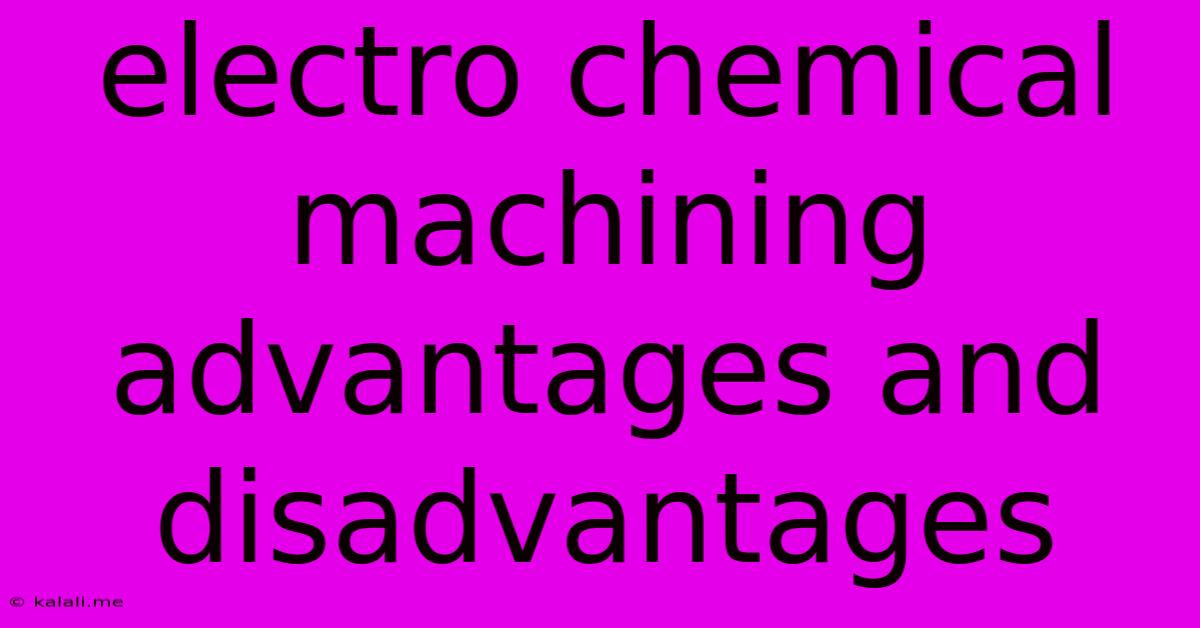Electro Chemical Machining Advantages And Disadvantages
Kalali
Jun 13, 2025 · 3 min read

Table of Contents
Electrochemical Machining (ECM): Advantages and Disadvantages
Electrochemical machining (ECM) is a non-traditional machining process that uses electrochemical reactions to remove material. Unlike traditional machining methods that rely on mechanical forces, ECM uses an electrically conductive electrolyte solution and an applied voltage to dissolve the workpiece material. This makes it ideal for machining hard-to-machine materials and complex shapes. However, it also presents certain limitations. Let's delve into the advantages and disadvantages of ECM.
Meta Description: Discover the key advantages and disadvantages of Electrochemical Machining (ECM), a non-traditional machining process used for hard-to-machine materials. Learn about its applications and limitations.
Advantages of Electrochemical Machining
ECM boasts several significant advantages over conventional machining processes:
-
Ability to Machine Hard Materials: This is perhaps ECM's most significant advantage. Materials like titanium alloys, nickel-based superalloys, and hardened steels, which are incredibly difficult or impossible to machine using traditional methods, can be easily shaped using ECM. The process isn't affected by the material's hardness, making it highly versatile.
-
Complex Shape Machining: ECM excels at creating intricate geometries and complex shapes with high accuracy. Undercuts, deep holes, and internal cavities that are impossible or impractical to machine using conventional methods are readily achievable with ECM. This opens up possibilities in various industries requiring intricate designs.
-
Minimal Tool Wear: Unlike traditional machining, the tooling in ECM doesn't experience significant wear. The tool acts as an electrode, and its shape is not affected by the machining process. This reduces tool replacement costs and downtime, leading to increased productivity.
-
High Material Removal Rate (MRR): ECM offers a high material removal rate, particularly when machining electrically conductive materials. This contributes to improved productivity and faster manufacturing cycles, resulting in cost savings.
-
Surface Finish Control: While not as fine as some other processes, the surface finish achievable with ECM can be controlled by adjusting parameters such as current density and electrolyte flow. This level of control is important for many applications.
-
Stress-Free Machining: Because the machining process doesn't involve any mechanical forces, it produces a stress-free surface finish on the workpiece. This is beneficial for components that are sensitive to stress, such as those used in aerospace applications.
-
Suitable for Brittle Materials: ECM can successfully machine brittle materials that are prone to cracking or chipping during traditional machining processes.
Disadvantages of Electrochemical Machining
Despite its numerous advantages, ECM also presents several limitations:
-
High Initial Investment: Setting up an ECM process requires a significant initial investment in specialized equipment, including power supplies, electrolyte tanks, and precision tooling. This makes it less cost-effective for smaller operations or low-volume production.
-
Electrolyte Management: ECM requires careful management of the electrolyte solution, including regular cleaning, filtration, and disposal. The electrolyte can be corrosive and needs to be handled responsibly, adding to operating costs and environmental concerns.
-
Limited to Electrically Conductive Materials: The process only works effectively on electrically conductive materials. Non-conductive materials cannot be machined directly using ECM.
-
Surface Finish Limitations: While controllable, the surface finish achievable with ECM might not be as smooth as that obtained through other precision machining techniques, especially when compared to processes like polishing. Further finishing processes may be required depending on application demands.
-
Accuracy Limitations: While ECM can produce complex shapes, maintaining very high levels of dimensional accuracy can be challenging. Precise control over process parameters is crucial to achieve the desired tolerances.
-
Hydrogen Embrittlement: In certain applications, the process can lead to hydrogen embrittlement, particularly in materials like high-strength steels. This can significantly affect the mechanical properties of the workpiece.
Conclusion
Electrochemical machining is a powerful technique with significant advantages for machining difficult materials and intricate shapes. However, its high initial investment, electrolyte management requirements, and limitations regarding material types and surface finish need careful consideration. The decision to employ ECM should be based on a thorough evaluation of its advantages and disadvantages in relation to the specific application requirements. Weighing these factors carefully will determine whether ECM is the optimal choice for a given machining task.
Latest Posts
Latest Posts
-
Which Of The Following Is True Of Customer Value
Jun 14, 2025
-
A Time Series Plot Is Also Known As A
Jun 14, 2025
-
How Fast Can A Peacock Run
Jun 14, 2025
-
What Is The Thickness Of The Crust Of The Earth
Jun 14, 2025
-
What Is The Highest Active Volcano In South America
Jun 14, 2025
Related Post
Thank you for visiting our website which covers about Electro Chemical Machining Advantages And Disadvantages . We hope the information provided has been useful to you. Feel free to contact us if you have any questions or need further assistance. See you next time and don't miss to bookmark.